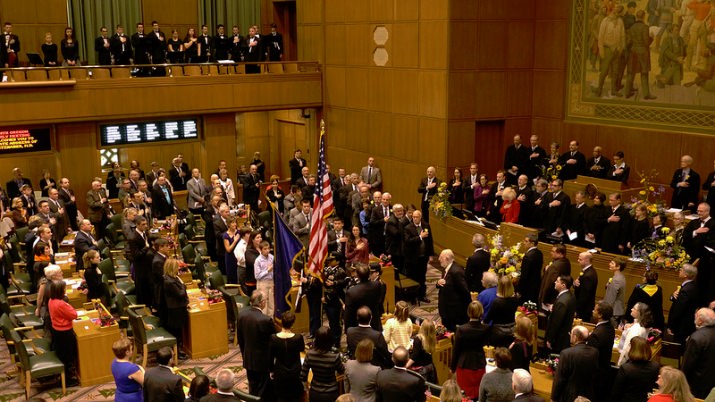Portland, July 1st, 2013. House Bill 2060 will eliminate state and local tax subsidies for charities spending more than 70 percent of donations on management and fundraising over three years. The new law may chase out nationally-based telemarketers who collect money in Oregon thereby making it easier for reputable local charities to raise funds. The bill is getting national attention with write-ups in publications like The Washington Post and is believed to be the first of its kind; it was passed June 4th, 2013. Oregon Attorney General Ellen F. Rosenblum is offering resources about the new regulations on the Oregon Department of Justice website.
The Nonprofit Association of Oregon is fielding questions about how HB 2060 will impact local charities. According to the Nonprofit Association of Oregon:
- An organization that fails to meet the 30% floor over the course of three years will be disqualified from receiving tax deductible donations for Oregon income tax purposes and will be required to notify its Oregon donors in writing of this fact before they make their giving decision. Such organizations to the extent they have Oregon property may also lose their property tax exemption.
- Donations made to an organization that has been disqualified in Oregon will not be tax deductible for Oregon income tax purposes, but will remain tax deductible for federal income tax purposes. However, this legislation will help to inform donors that the disqualified charity is one they may not wish to support and many prospective donors upon receiving this information will chose to make their donations to more effective organizations.
The Oregon Department of Justice’s (DOJ) Charitable Activities Section anticipates that relatively few Oregon charities will be impacted by this legislation; rather, it will only affect organizations that rely heavily on professional fundraising companies that keep most of the donations. Small nonprofits (generally those making less than $200,000) are exempt from HB 2060, and additional exemptions take into account circumstances that can lead to high management and fundraising costs among organizations that are otherwise dedicated to their charitable missions.
Contact DOJ’s Charitable Activities Section with any questions or concerns regarding this legislation through the Section’s email address, which is [email protected].
Frequently Asked Questions:
If organizations are raising funds and not spending them on their missions, what do they spend the funds on?
The majority of nonprofits that would fall afoul of this law use the funding for marketing and fundraising. Unfortunately, numerous telemarketing companies have realized that they can set up or become associated with a nonprofit, raise funds under contract, and then give only a small portion of those funds to the nonprofit. This bill was designed to weed out that kind of organization. Each organization on the annualOregon Attorney General’s Twenty Worst Charities List falls below the 30% mark and all are located outside of Oregon. These bad apples tarnish the nonprofit sector and cause us all to look bad. Take a look at this recently released major investigative report into the type of charities impacted by HB 2060.
How is the 30% program expenditure threshold calculated?
The program expenditure calculation is based on the full IRS Form 990 Part IX Statement of Functional Expenses, using a three-year average.
Does this legislation impose any new record keeping or accounting requirements on organizations with budgets over $200,000?
No. Currently, organizations with gross receipts exceeding $200,000 are already required to file the full IRS Form 990—which includes the Part IX Statement of Functional Expenses—and register with the Attorney General.
In order to complete the Part IX Statement of Functional Expenses, organizations must already have a reasonable method of allocating their expenses between program, management, and fundraising. In addition, organizations must maintain documentation that supports the information contained in their returns. Accordingly, an organization documents compliance with this legislation the same way it documents compliance with existing 990 requirements.
Even before and apart from this legislation, the Charitable Activities Section of DOJ has recommended that organizations be cognizant that the 990 is a public document. The public and the media often look to the 990’s Statement of Functional Expenses for an understanding of how the organization is utilizing the funding it receives. An organization consistently reporting that it spends less than 30% on program services should be prepared to explain why that is the case and may want to incorporate that explanation into Schedule O.
Will nonprofits with budgets under $200,000 now have to keep records that document functional versus other expenses?
No. One goal of this legislation was to avoid imposing any additional obligations on nonprofits beyond their current reporting requirements. Small nonprofits—990N and 990EZ filers—are not required to complete the full 990 and therefore are not affected by this legislation.
What general steps can organizations take to avoid falling below the 30% mark?
It is highly unlikely that nonprofits filing the full IRS Form 990 will fall below the 30% program expenditure threshold as long as such organizations make some effort to reasonably allocate expenses. Many types of expenses can be properly allocated to charitable programs as opposed to management and administration.
Example 1: An organization with a small paid administrative staff, unpaid Board members, and program volunteers that rents a facility and uses part of that facility to provide program services should allocate a portion of the rent to program services. Similarly, if any of the paid staff’s time is spent engaged in program services, then a portion of that person’s salary can be allocated to program services.
Example 2: The salary of a single staff person that performs only management functions for a nonprofit that has annual expenditures in the vicinity of $200,000 would have to be fairly high (i.e. around 70% of its expenditures or $140,000) to be impacted by this legislation. That seems like an unlikely situation.
Organizations that have reviewed the 990 Part IX Statement of Functional Expenses and still believe they will be unfairly impacted by the legislation because of exceptional circumstances are encouraged to contact the Charitable Activities Section for assistance:[email protected].
How will organizations and the public be informed of their disqualified status?
The Charitable Activities Section is in the process of developing additional guidelines related to this new law, but the law requires that the charity be given advance notice of the disqualification determination. The charity will then have the ability to challenge that determination under the framework provided by the Oregon Administrative Procedures Act. Assuming the determination is upheld, the disqualification order will become effective and remain in effect until the charity demonstrates that its program services expenditures meet the 30% threshold requirement.
The listing of disqualified organizations will be posted on the Department’s website. Donors will not be able to claim a tax deduction for contributions made more than 30 days after the charity’s disqualified status was posted to the Department’s website, unless the donor has a receipt from that charity that did not include information about the charity’s disqualified status.
Many nonprofits operating in Oregon could be effected including those on The Attorney General’s 20 worst charities of 2012. That list was published in December. Charities are required to file periodic financial reports with the Oregon Department of Justice documenting their national fundraising and expenditures and explaining how donations were spent. Under guidelines issued by the Better Business Bureau (BBB), organizations should dedicate at least 65% of their funds to charitable programs, with no more than 35% toward administrative and fundraising costs. The following charities registered to do business in Oregon failed to meet that standard based on a three-year average of annual expenditures. This is not an exclusive list, but represents the 20 charities that fell farthest from the BBB guidelines. For more
information, visit http://www.oregonattorneygeneral.gov.
Organization Average Annual Percent Spent On Expenditures Charitable Cause
Law Enforcement Education Program $2,299,994. Percent Spent On Expenditures Charitable Cause: 2.7%
Troy, MI Purpose: To create and support educational programs for the betterment of both the general public and the law enforcement community.
Shiloh International Ministries $846,340. Percent Spent On Expenditures Charitable Cause: 3.2%
La Verne, CA
Purpose: To improve the quality of life of America’s disabled and needy children
by providing medical necessities and moral support.
American Medical Research Organization $783,217. Percent Spent On Expenditures Charitable Cause: 4.2%
Sarasota, FL
Purpose: To support medical research in the cause, cure, and treatment of macular degeneration.
Firefighters Support Foundation $3,263,878. Percent Spent On Expenditures Charitable Cause: 7.0%
Greenfield, MA
Purpose: To offer training programs and support injury prevention initiatives for
firefighters and other first responding public safety agencies.
Disabled Police Officers Counseling Center, Inc. $681,599 7.4%
Niceville, FL
Purpose: To provide educational and counseling programs to assist disable police officers, and to educate the public on the needs and abilities of disabled police officers.
Woman to Woman Breast Cancer Foundation, Inc. $4,921,015 8.0%
Lauderdale Lakes, FL
Purpose: To support women by promoting regular examinations, early detection and aggressive treatment for those suffering from breast cancer.
Disabled Police Officers of America $1,488,122 8.8%
Officers of America Niceville, FL
Purpose: To provide financial scholarships to those disabled and retired law enforcement officers requesting them.
Firefighters Charitable $6,924,179 8.8%
Foundation
Farmingdale, NY
Purpose: To provide financial assistance to individuals who have been affected by a fire or disaster and to support other disaster or prevention related charities, and volunteer fire departments.
The Wishing Well $1,249,566 10.0%
Foundation
Metairie, LA
Purpose: Fulfilling the fondest wish for any terminally ill child not expected to reach 18 years of age. 3
Foundation for American Veterans, Inc. $6,655,583 10.2%
West Bloomfield, MI
Purpose: Promoting social and recreational welfare for current and past U.S.
Armed Forces members, dependents, widows, widowers and others.
Dogs Against Drugs/Dogs Against Crime $1,042,284 11.1%
Anderson, IN
Purpose: Dedicated to the betterment of law enforcement K9 operations
throughout the United States.
National Vietnam Veterans Foundation $4,374,031 11.2%
Alexandria, VA
Purpose: Funding of programs and projects which benefit American veterans and their families.
Operation Lookout National Center for Missing Youth $1,589,751 11.5%
Everett, WA
Purpose: To locate missing children.
Committee for Missing Children $2,368,192 12.1%
Lawrenceville, GA
Purpose: Distribute pictures of missing children by encouraging educational
dealers, manufacturers and publishers to produce pages of missing children and
distribute them throughout the country.
Law Enforcement Legal Defense Fund $2,932,662 14.6%
Arlington, VA
Purpose: Conduct research on legal issues, use and publish results of such
research; support and engage in litigation safeguarding human and civil rights;
and assist similar charitable and educational organizations. 4
Caring for Our Children Foundation $618,658 15.3%
Everett, WA
Purpose: Provide administrative assistance to other non-profits and give small
grants to underfunded nonprofits that help victimized and missing children.
United American Patriots, Inc. $1,625,517 18.4%
Greensboro, NC
Purpose: To value individual liberty, protect and preserve the Constitution of the
United States and our national sovereignty, to promote Free Enterprise, National
Defense, traditional American Values and the education of youth.
National Veterans Service Fund $9,333,238 18.8%
Darien, CT
Purpose: To inform and educate in conjunction with service-related illnesses and
work to raise public awareness of the contributions of veterans to our society.
American Border Patrol $1,383,812 20.8%
Sierra Vista, AZ
Purpose: To monitor the border on regular basis and to educate the public about
border control issues.
Dakota Indian Foundation $1,255,942 21.7%
Chamberlain, SD
Purpose: Assist in education of Indian people and preservation of Native
American culture.
Another way to vet nonprofits is the Charity Navigator.
















